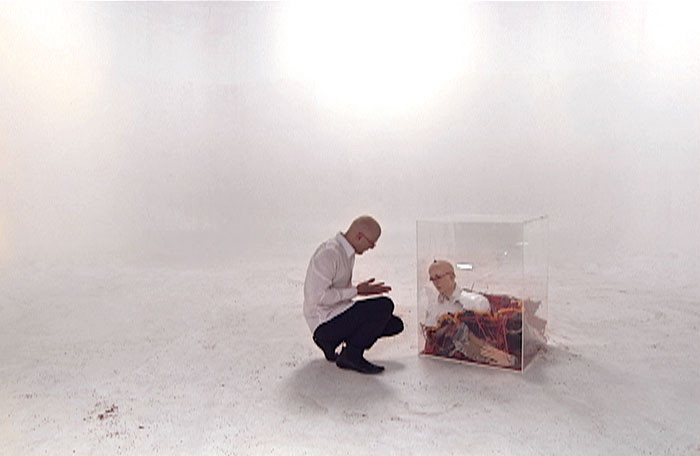Gabriel de la Mora
13 Oct - 20 Dec 2007

© Gabriel de la Mora
39-G.M.C-23.sept.07, 2007
Digital video in two channels
20 min, 12 sec.
Ed. of 5 + 2 PA
(GM 45)
39-G.M.C-23.sept.07, 2007
Digital video in two channels
20 min, 12 sec.
Ed. of 5 + 2 PA
(GM 45)
GABRIEL DE LA MORA
"Brújula de cuestiones"
Identifying and examining the mark of history has been a constant of existential quests. Art practice has persistently sought to articulate new forms of identification. In Brújula de cuestiones (Compass of questions), Gabriel de la Mora (Colima, Mexico, 1968) plays with and disarticulates the scope and limits of his own mark—a deconstruction of myths and truths about the family that leads to a new construct of personal history in which the presence/absence dichotomy structures the possibility of a genealogical archaeology and a “new” identity.
One of this exhibition’s leitmotivs is to question the ideal of knowing the truth as a way of representing the world through the depiction of a simulated reality. The photographic documentation of the family is presented as the illusion of a truth that never came to exist: events that are not in any way lies but rather simulations, veiled truths or, as Derrida might have said, “the truth behind the truth and so on, ad infinitum.”
This exhibition presents the work that De la Mora has been making with (natural human and synthetic) hair over the past four years. Hair as a portrait of a silenced voice that nonetheless continues to speak; the receptacle and container of one of our most particular, primordial, defining and univocal marks: DNA. The pieces made with this material are based on a figurative portrait that dissolves until it becomes a clearly conceptual and personal kind of portrait: a signature and fingerprint.
In turn, Gabriel de la Mora presents a new possibility: a group portrait of seventeen members of his family, featuring (and recognizing or “re-knowing”) his father and sister, who died, respectively, fourteen and thirty-six years ago. A fabricated scene: impossible from a chronological point of view, but made possible by the act of creation itself. One’s bone structure as a universal—i.e. unifying—element, in which gender, religious, social, ethnic differences (etc.) are not readily decipherable. The skull or cranium: a feature unifying the living as well as the dead.
Brújula de cuestiones sparks a series of readings in which we may question the relevance of the limits that each one of us is encumbered by because of our very personal —or general— history.
"Brújula de cuestiones"
Identifying and examining the mark of history has been a constant of existential quests. Art practice has persistently sought to articulate new forms of identification. In Brújula de cuestiones (Compass of questions), Gabriel de la Mora (Colima, Mexico, 1968) plays with and disarticulates the scope and limits of his own mark—a deconstruction of myths and truths about the family that leads to a new construct of personal history in which the presence/absence dichotomy structures the possibility of a genealogical archaeology and a “new” identity.
One of this exhibition’s leitmotivs is to question the ideal of knowing the truth as a way of representing the world through the depiction of a simulated reality. The photographic documentation of the family is presented as the illusion of a truth that never came to exist: events that are not in any way lies but rather simulations, veiled truths or, as Derrida might have said, “the truth behind the truth and so on, ad infinitum.”
This exhibition presents the work that De la Mora has been making with (natural human and synthetic) hair over the past four years. Hair as a portrait of a silenced voice that nonetheless continues to speak; the receptacle and container of one of our most particular, primordial, defining and univocal marks: DNA. The pieces made with this material are based on a figurative portrait that dissolves until it becomes a clearly conceptual and personal kind of portrait: a signature and fingerprint.
In turn, Gabriel de la Mora presents a new possibility: a group portrait of seventeen members of his family, featuring (and recognizing or “re-knowing”) his father and sister, who died, respectively, fourteen and thirty-six years ago. A fabricated scene: impossible from a chronological point of view, but made possible by the act of creation itself. One’s bone structure as a universal—i.e. unifying—element, in which gender, religious, social, ethnic differences (etc.) are not readily decipherable. The skull or cranium: a feature unifying the living as well as the dead.
Brújula de cuestiones sparks a series of readings in which we may question the relevance of the limits that each one of us is encumbered by because of our very personal —or general— history.
